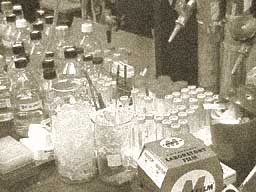|
|
 |
 |
DNA isolation
(zymolyase) from
Wangiella dermatitidis
M. Momany and P.J. Szaniszlo
|
Index:
(to jump to a listing, click on the desired name to the right) |
Materials
Protocol
Results
Tips |
| |
Principle
and General Applications |
| |
This method is a scaled-up version of a
simple mini prep used for isolating DNA from the yeast Saccharomyces cerevisiae
(Treco, 1989). It works quite well on yeast-phase Wangiella dermatitidis. |
| |
(Back to
the top) |
| |
Materials |
| |
10% sodium dodecyl sulfate (SDS); 5 M
potassium acetate; Dnase-free Rnase; Ethanol; Isopropanol; Sorbitol solution: 0.9M
sorbitol, 0.1 M Tris, pH 8.0; 0.1 M EDTA; TE buffer; Tris/EDTA solution: 50 mM Tris, pH
8.0; 20mM EDTA; YPD medium: 1% yeast extract, 2% glucose, 2% peptone, Zymolyase |
| |
(Back to
the top) |
| |
Protocol |
| |
- Begin with 100 ml stationary phase W. dermatitidis
(2 days at room temperature in YPD). Split this culture into 50 ml disposable
polypropylene types and centrifuge 5 min in a clinical centrifuge at full speed (1,200 x
G).
- Resuspend cell pellet in a total of 15 ml sorbitol solution
by vortexing. Add 100 µl of 3 mgml –1 zymolyase and 11 µl B-mercaptoethanol to the
sorbitol solution and incubate at 37 C with slow shaking to spheroplast.
- After 1 hr check spheroplasting by viewing culture
microscopically. After adding a drop of water at the corner of the coverslip, osmotically
sensitive cells will burst. If less tha 90% of the cells are osmotically sensitive, add
more zymolyase and continue incubation. Check spheroplsting at 15 min intervals. When
spheroplasting is complete centrifuge 5 min in clinical centrifuge at full speed (1,200 x
G).
- Resuspend spheroplasts in 3 ml of Tris/EDTA solution by
gently pipeting up and down. Transfer 0.5 ml aliquots to 1.5 ml microfuge tubes.
- To each tube add 50 ul 10% SDS, invert to mix. Incubate 20
min at 65ºC.
- Add 200 µl of 5 M potassium acetate, mix by inversion, and
incubate on ice for 30 min. Microfuge 3 min.
Transfer supernatant to clean microfuge tube and add
1 ml ehtanol. Mix by inversion. Microfuge 5 min at room temperature. Pipette off ethanol
and dry pellet in dessicator or speed vac. Dissolve pellet in 100 µl TE buffer.
- Combine three 100 µl aliquots in a single microfuge tube (you should
now have two tubes each containing 300 µl). Add 40 µl of a solution containing 10 mgml-1
Dnase-free Rnase A per tube. Incubate 1 hr at 37
ºC.
- Precipitate DNA with 0.5 ml isopropanol. Mix gently so that DNA
clumps into a single ball. Remove DNA on a pippettor tip to 125 µl TE. Try not to carry
liquid over.
|
| |
(Back to
the top) |
| |
Results |
| |
Typical yields are greater than 500 ul DNA
per 300 ml W. dermatitidis stationary culture. The DNA from the prep has been
used successfully for Southerns, PCR, and cloning (Bowen et al., 1992; Momany, 1992;
Szaniszlo and Momany, 1992). |
| |
(Back to
the top) |
| |
Tips |
| |
- Occasionally, the DNA from the isopropanol
precipitation step does not clump into a visible ball , especially if the yield of DNA is
low. In this case, the DNA may be recovered by a 15 min microfuge spin and washed with 70%
ethanol.
|
| |
(Back to
the top) |
 |
This page updated on:
Monday, March 03, 2003 11:05:53 PM |
|
|
|
|